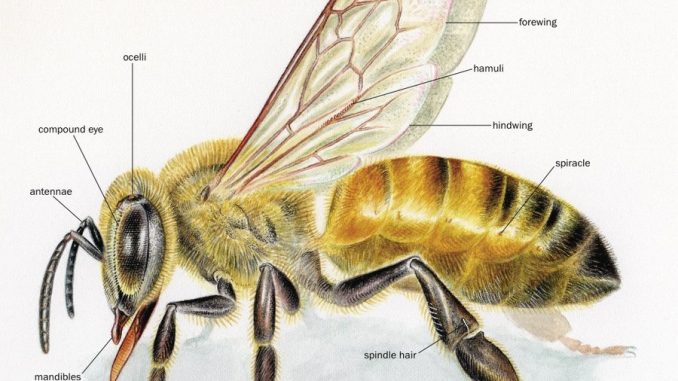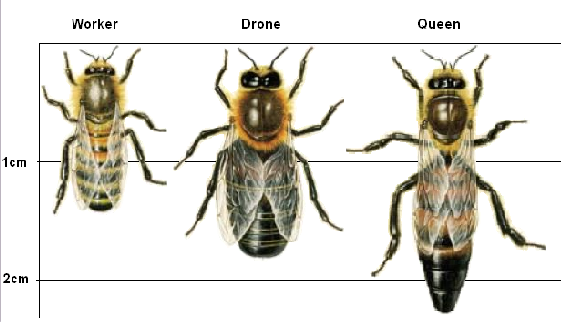
- Honey bees are social insects, which means that they live together in large, well-organized family groups.
- They are useful to us as they produce honey, wax, propolis etc. that can be used by humans
- Some of the behaviors like communication, complex nest construction, environmental control, defense, and division of the labor developed in honeybees help them exist successfully in social colonies.
- Honey bee belongs to the class Insecta of phylum Arthropoda of Animal kingdom.
- Different species of honey bees have been studied so far. Apis dorsata (The rock bee), Apis cerana (The Indian hive bee), Apis florea (The little bee), Apis mellifera (The European or Italian bee) are few of them.
- A honey bee colony typically consists of three kinds of bees: workers, drones, and a queen.
- The average population of a healthy hive in mid-summer may be as high as 40,000 to 80,000 bees in which there is a single queen, a few hundred drones and thousands of worker bees.
External morphology of honey bee:
- The bodies of bees are divided into three regions; head, thorax and abdomen.
- The thorax consists of three pairs of legs and two pairs of wings.
- The head consists of a pair of antennae, a pair of compound eyes and mouth parts.
- The abdomen is elongated and segmented.
Queen bee:
- Each colony has only one queen, except during swarming
*Swarming is the process in which the queen bee leaves the colony with a large group of worker bees to form a new colony. The new queen takes the place of the former queen gone for swarming.
- A queen has a much longer body than either the drone’s or worker’s, especially during the egg-laying period when her abdomen is greatly elongated.
- She has short wings and small proboscis, and with neither pollen baskets nor functional wax glands.
- The stinger present at the tip of abdomen is curved and longer than that of the worker, but it has fewer and shorter barbs.
- She is the only sexually developed female and produces both fertilized and unfertilized eggs.
- During peak production, a queen may lay up to 1,500 eggs per day and may produce up to 250,000 eggs per year and possibly more than a million in her lifetime.
- The average productive life span of queen is 2 to 3 years queen but can live for several years, sometimes for as long as 5.
- The queen also produces pheromones that serve as a social “glue” unifying and helping to give individual identity to a bee colony.
- She only feeds on royal jelly.
*Royal jelly is a protein rich, whitish milky fluid, produced from the nurse glands of worker bees when they are 7-11 days old. Younger larvae (first 3 days of larval stage) and the queen are fed only with the royal jelly.
Drones:
- They are 200-300 in number in a colony.
- They develop from the unfertilized eggs by the process of parthenogenesis.
- Its head is much larger as compared to the queen or worker, and the compound eyes meet at the top of its head dorsally.
- They are generally present only during late spring and summer when mating occurs with the queen.
- Drones have no stinger, pollen baskets, or wax glands.
- Drones become sexually mature about a week after emerging from the cell in a hive and fertilize the virgin queen during her mating flight and die instantly upon mating.
- During cold weather like in the fall, pollen/nectar resources become scarce and hence the drones usually are forced out into the cold and left to starve to reduce the burden in the hive.

Workers:
- They are the smallest and constitute the majority of bees occupying the colony.
- In a normal colony of 40,000 bees, there are about 39,700 worker bees.
- The life span of a worker bee is about 6 weeks.
- They are sterile females and under normal hive conditions do not lay eggs.
- They have specialized structures (brood food glands, scent glands, wax glands, and pollen baskets) which allow them to perform all the labor or works of the hive.
- Their mouth is modified for chewing and lapping.
- The tongue is long which is used to suck up nectar and pollen from the flowers.
- A pair of mandibles help to manipulate was during comb building.
- The fore (front) pair of legs carry a row of hairs which clean antennae.
- Another row of hairs called pollen comb cleans the pollen from the head and mouth parts and passes it to the hind legs.
- The intestine consists of honey stomach or the crop that stores the nectar collected during the flight.
- They have sting and a sac of venom located at the tip of the abdomen.
- They carry out special functions at different stages such as cleaning and polishing the cells, feeding the brood, caring for the queen, removing debris, handling incoming nectar, building beeswax combs, guarding the entrance, and air-conditioning and ventilating the hive during their initial few weeks as adults.
- Later, they forage for nectar, pollen, water, and propolis (plant sap).
Table: Division of labor in honey bee on the basis of their type
| S.N. |
Type and Age |
Functions/ Duties |
| 1. | The queen bee | · To lay eggs · To control and guide the colony by releasing pheromone (special odor) |
| 2. | Drone | · To fertilize the queen |
| 3. | Worker (1-3 days old) | · To give warmth to eggs, larva and pupae
· To clean the cells |
| 4. | Worker (4-6 days old) | · To feed older larvae with honey and pollen |
| 5. | Worker (7-11 days old) | · To feed royal jelly produced from their nurse glands to the queen and younger larvae (below 3 days) |
| 6. | Worker (12-17 days old) | · To produce wax and build a honey comb
· To seal the cells of the larvae and honey |
| 7. | Worker (18-20 days old) | · To protect the bee hive from enemies and ventilate the hive |
| 8. | Worker (21 days onwards) | · To collect nectar, pollen, propolis and water |
